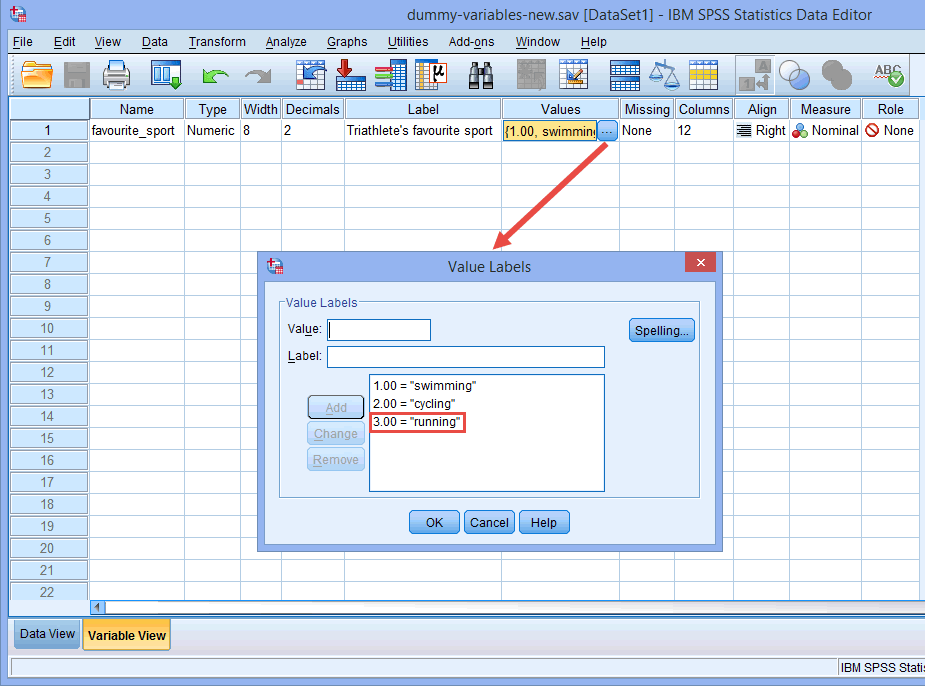

- Spss code data install#
- Spss code data full#
- Spss code data download#
7.12 Missing data in continuous variables. 7.10 Multilevel Multiple Imputation models. 7.9 Sporadically and systematically missing data. 7.7 Restructuring from wide to long in R. 7.6 Restructuring from wide to long in SPSS. 7.5 Longitudinal Multilevel data - from wide to long. 7.4 Multilevel data - Clusters and Levels. 7.1 Advanced Multiple Imputation models for Multilevel data. 7 Multiple Imputation models for Multilevel data. V Part V: Advanced Multiple Imputation methods. 6.4.2 Variable Selection with Cox Regression models in R. 6.4.1 Variable Selection with Logistic Regression models in R. 6.3 Cox Regression with a categorical variable in R. 6.2 Logistic regression with a categorical variable in R. 6.1 Regression modeling with categorical covariates. 6 More topics on Multiple Imputation and Regression Modelling. 5.2.6 Analysis of Variance (ANOVA) pooling. 5.2.2 Pooling Means and Standard Deviations in R. 5.2.1 Pooling Means and Standard deviations in SPSS. 5 Data analysis after Multiple Imputation. IV Part IV: Data Analysis After Multiple Imputation. 4.14 Number of Imputed datasets and iterations. 4.13 Imputation of categorical variables. 4.12.1 Predictive Mean Matching, how does it work?. 4.12 Predictive Mean Matching or Regression imputation. 4.10 Guidelines for the Imputation model. 4.4 The output of Multiple imputation in SPSS. 4.1 Multivariate imputation by chained equations (MICE). 3.4.2 Bayesian Stochastic regression imputation in R. 
3.4.1 Bayesian Stochastic regression imputation in SPSS.3.4 Bayesian Stochastic regression imputation.

3.3.4 Stochastic regression imputation in R.2.8.2 Compare and test group comparisons.
 2.7.2 Compare and test group comparisons. II Part II: Basic Missing Data Handling. 1.15 Useful Missing data Packages and links. 1.6.4 Indexing Vectors, Matrices, Lists and Data frames. 1.6.3 Vectors, matrices, lists and data frames. There are no options for SPSS or Stata files. The default is YES.įor SAS you can specify the dataset name within the uri with DSET. READNAMES - whether to read variable names from the first row of the range. CELLRANGE - the range to read within the sheet. You cannot specify both the name and the number. SHEETNUMBER - the number of the sheet to read. SHEETNAME - the name of the sheet to read. ASSUMEDSTRWIDTH - the width to use for string variables. Options are specific to the file type and are ignored if they do not apply. Location, it may or may not be overwritten depending on the operating system.
2.7.2 Compare and test group comparisons. II Part II: Basic Missing Data Handling. 1.15 Useful Missing data Packages and links. 1.6.4 Indexing Vectors, Matrices, Lists and Data frames. 1.6.3 Vectors, matrices, lists and data frames. There are no options for SPSS or Stata files. The default is YES.įor SAS you can specify the dataset name within the uri with DSET. READNAMES - whether to read variable names from the first row of the range. CELLRANGE - the range to read within the sheet. You cannot specify both the name and the number. SHEETNUMBER - the number of the sheet to read. SHEETNAME - the name of the sheet to read. ASSUMEDSTRWIDTH - the width to use for string variables. Options are specific to the file type and are ignored if they do not apply. Location, it may or may not be overwritten depending on the operating system. Spss code data download#
If a file with the same name exists in the download If the filetype is OTHER, the SAVE keyword is required and specifies the directoryįor the download. You can optionally use DATASET to assign a dataset name to the opened file. For example,įILETYPE specifies the type of file to read. If the name is too long for an SPSS literal, write it as multiple quoted
Spss code data full#
URI specifies the full web address including the protocol such as or ftp:// OPTIONS SHEETNUMBER=1 READNAMES=YES ASSUMEDSTRWIDTH=100. HELP displays this help and does nothing else. SPSSINC GETURI DATA URI=" uri including filename"^* "."įILETYPE=SPSS^** or XLS or SAS or STATA or OTHER
Search for the name of the extension and click Ok. Spss code data install#
Navigate to Utilities -> Extension Bundles -> Download and Install Extension Bundles. Note: For users with IBM SPSS Statistics version 23 or higher, the SPSSINC GETURI DATA extension is installed as part of IBM SPSS Statistics-Essentials for Python. IBM SPSS Statistics 18 or later and the corresponding IBM SPSS Statistics-Integration Plug-in for Python. It can be used to download and save files of other typ es, but these will not be opened. This command takes a URL as input and downloads and opens a data file. SPSSINC GETURI DATA Open an SPSS, Excel, SAS, or Stata dataset from a web url.








 0 kommentar(er)
0 kommentar(er)
